The Sweet Treat of Turkey
If you have ever read Chronicles of Narnia by C.S. Lewis you have probably wondered about the sweet snack the witch used to lure 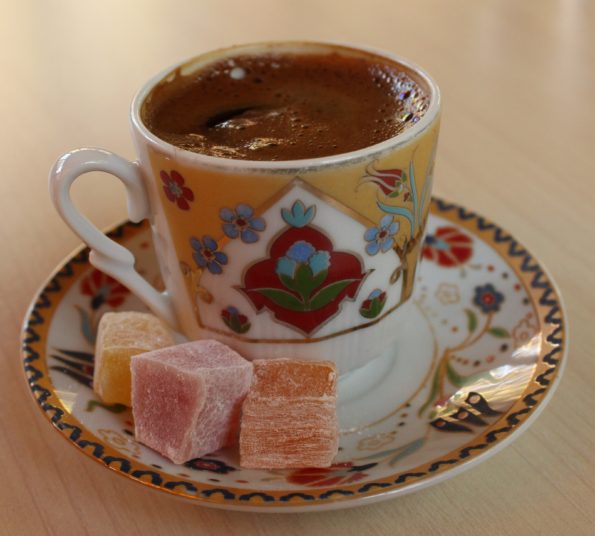 Edmund into captivity. Or if you have ever been privileged enough to visit Turkey, even for a day, you have surely enjoyed this delectable treat yourself and wondered about its uniqueness.
Edmund into captivity. Or if you have ever been privileged enough to visit Turkey, even for a day, you have surely enjoyed this delectable treat yourself and wondered about its uniqueness.
Lokum (Turkish Delight) is a gooey cube made with three main components: sugar to sweeten, water to bind, and starch to add texture. This sweet treat isn’t just a delight to eat but has many benefits. Due to the fact that Turkish Delight is a carbohydrate source, doctors actually recommend that kidney patients eat this tasty treat. It has also been known to help acne, boils & scars. The chewy textures help to strengthen the teeth and reduce tonsillitis.
Lokum is a special treat served at festivals and holidays. It is also a very common sweet served daily alongside Turkish Coffee in cafes or offered to welcome guests into your home.
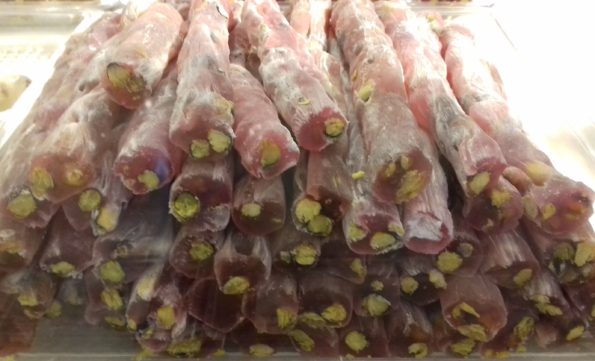 While the exact origin of Turkish Delight is shrouded in a lot of hearsay, it can definitely be dated back to 16th century Anatolia, possibly even earlier. It’s believed that the sultan asked his council to find the best cooks possible who could work to make a dessert so delectable that it would ease the division and disorder in his harem. The court confectioners developed a sweet treat originally called rahat ul-huküm which means “comforting the throat” which was widely loved throughout the Ottoman Empire. In the 18th century European travelers took this delectable dessert home with them and it became known as Turkish Delight. Today Turkish Delight is well-known around the globe and a major source of pride and export for Turkey. In 2016 alone Turkey exported $30 million worth of Turkish Delight! In Turkey Lokum has a wide price range. The simplest and most common squares are either plain, mint or rose flavored and cost about $1 per pound. Other popular flavors include hazelnuts, walnuts, pistachios, pomegranate, crushed rose petals, saffron, coconut and can even sometimes be found covered in chocolate. The most expensive of these fancy combinations cost about $50 per pound.
While the exact origin of Turkish Delight is shrouded in a lot of hearsay, it can definitely be dated back to 16th century Anatolia, possibly even earlier. It’s believed that the sultan asked his council to find the best cooks possible who could work to make a dessert so delectable that it would ease the division and disorder in his harem. The court confectioners developed a sweet treat originally called rahat ul-huküm which means “comforting the throat” which was widely loved throughout the Ottoman Empire. In the 18th century European travelers took this delectable dessert home with them and it became known as Turkish Delight. Today Turkish Delight is well-known around the globe and a major source of pride and export for Turkey. In 2016 alone Turkey exported $30 million worth of Turkish Delight! In Turkey Lokum has a wide price range. The simplest and most common squares are either plain, mint or rose flavored and cost about $1 per pound. Other popular flavors include hazelnuts, walnuts, pistachios, pomegranate, crushed rose petals, saffron, coconut and can even sometimes be found covered in chocolate. The most expensive of these fancy combinations cost about $50 per pound.
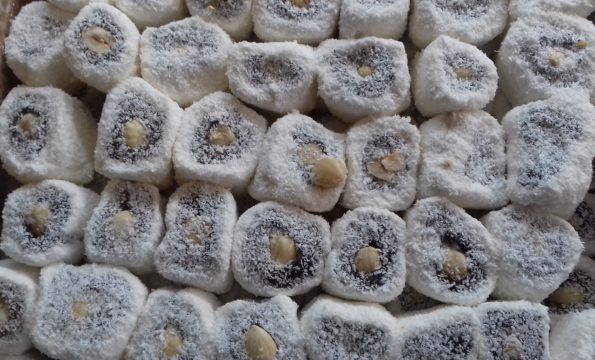 While there is great variety in the flavors and price of Turkish Delight, there are a few important characteristics that tie them all together. Each bite must be tender & chewy. It should be flexible enough that after being squeezed like a sponge will return to its original shape. As mentioned at the beginning, sugar, water & starch are the key ingredients as well as a variety of nuts, fruit and other flavorings. Turkish Delight has evolved since its conception where originally they used molasses and flour in place of sugar and starch. It is a long process to get the correct combination of sticky and soft, tender and firm, which involves a 2-hour cooking process. Then the mixture sits for 20 hours before it can be diced up and served.
While there is great variety in the flavors and price of Turkish Delight, there are a few important characteristics that tie them all together. Each bite must be tender & chewy. It should be flexible enough that after being squeezed like a sponge will return to its original shape. As mentioned at the beginning, sugar, water & starch are the key ingredients as well as a variety of nuts, fruit and other flavorings. Turkish Delight has evolved since its conception where originally they used molasses and flour in place of sugar and starch. It is a long process to get the correct combination of sticky and soft, tender and firm, which involves a 2-hour cooking process. Then the mixture sits for 20 hours before it can be diced up and served.
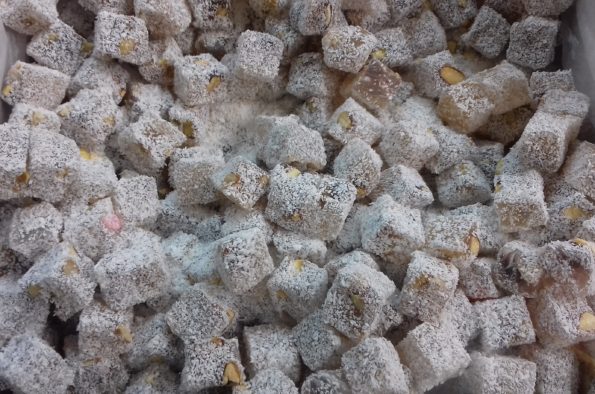 Every time before leaving Turkey to visit the States, I make sure to buy quite a few pounds’ worth of Turkish Delight for friends and family to enjoy back home. Shopping for it is a grand experience and should be done with a nearly empty stomach as each seller will offer you a taste test of each type before you buy. With such a vast variety of flavors it’s a difficult choice and I usually end up buying lots more than originally planned… and yet it always disappears quite fast and I never have any left! With such easy access to Turkish Delight here I have never attempted making it at home but have done quite a bit of research about the process and am just waiting for a brave friend to try using American ingredients and a normal home kitchen before I post a recipe to share with you. (Stay tuned for the recipe to appear soon!)
Every time before leaving Turkey to visit the States, I make sure to buy quite a few pounds’ worth of Turkish Delight for friends and family to enjoy back home. Shopping for it is a grand experience and should be done with a nearly empty stomach as each seller will offer you a taste test of each type before you buy. With such a vast variety of flavors it’s a difficult choice and I usually end up buying lots more than originally planned… and yet it always disappears quite fast and I never have any left! With such easy access to Turkish Delight here I have never attempted making it at home but have done quite a bit of research about the process and am just waiting for a brave friend to try using American ingredients and a normal home kitchen before I post a recipe to share with you. (Stay tuned for the recipe to appear soon!)
The cheapest lokum to buy are these little cubes of mixed variety: plain, rose, mint, lemon & orange flavors

The most traditional kind of Turkish Delight is a simple square of Rose flavored lokum
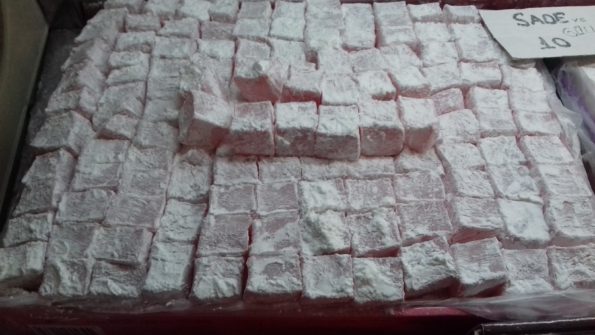
My personal favorite is the pomegranate lokum with pistachio nuts and covered in coconut flakes


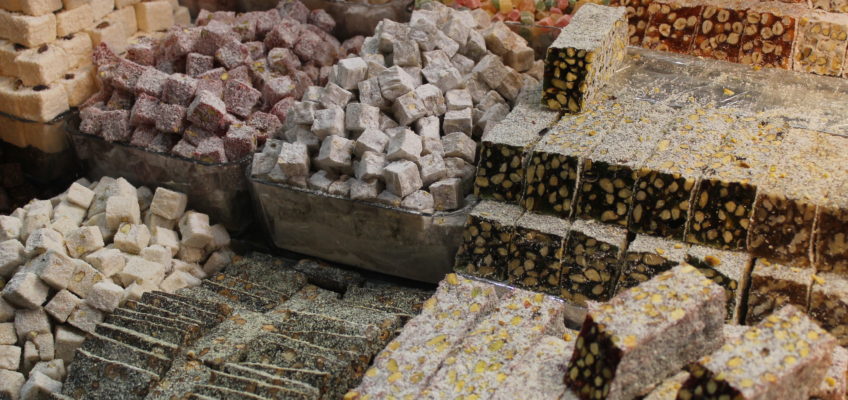

Terry Bevels
Yummy.